A new Greenpeace report has highlighted the glaring inadequacies in Europe's rail network, particularly in Central and Southeast Europe, driving residents of the region to rely heavily on air travel.
The study, conducted by Greenpeace Central and Eastern Europe, analysed 990 routes between 45 major European cities, finding that only 12% are served by direct train connections, compared to 69% served by direct flights.
The situation is worst in the six non-EU Balkan countries — Albania, Bosnia & Herzegovina, Kosovo, Montenegro, North Macedonia and Serbia — which have the poorest cross-border rail connections in Europe.
All six countries lack international train connectivity, leaving them isolated from the broader European network; sole cross-border train route in the region is the night train between Belgrade and Montenegro. Of the six cities deemed by Greenpeace to be the worst connected by direct train, three are in the Western Balkans — Pristina, Sarajevo and Skopje.
The situation is even worse in worst in Albania, whose capital Tirana was not included in the ranking as it has been without a railway station since it was demolished in 2013.
Plans are underway to build new rail connections across the region, including in Albania, many of them with support from multilateral development banks and international donors. However, in the meantime, the Western Balkans countries lack connections both within and outside of the region.
“Despite all countries having operational railway companies, four countries only have domestic rail connections, and cannot be reached by train from any other country: Albania, Bosnia, Kosovo and Northern Macedonia,” points out the report.
“Serbia is the only country of these six which can be reached by train from another country. However, the only way to enter Serbia is the route Budapest–Belgrade, with three transfers in Szeged, Subotica and Novi Sad. Current refurbishments on this route are supposed to be finished in 2025, leading to a hopefully better rail connectivity of Belgrade.” The landlocked country does, however, lack connections to its other neighbours, Bulgaria, Croatia and Romania.
Moreover, the report points out that the rail connections that do exist are very slow. “This region would benefit most from upgrading the existing tracks to an average speed of 80 km/h. For example, it would then be possible to reach Sarajevo by train from 17 more cities,” says the report.
Withered away
The dire situation in the Western Balkans comes in the context of a region where there are “huge gaps” in rail connectivity, according to Herwig Schuster, a transport campaigner for Greenpeace Central and Eastern Europe.
The study reveals that 42% of the analysed routes across Central and Southeast Europe could be served by direct trains with a journey time of less than 18 hours using existing tracks. However, only 27% of these potential direct train routes are currently utilised, leaving a considerable number unserved. The untapped potential for direct train connections could more than triple with improvements to existing infrastructure.
Greenpeace criticises the lack of investment and political will as key barriers to improving rail connectivity.
"Europe has rolled out the red carpet for climate-damaging air travel, showering it with tax breaks, while trains and rail infrastructure have withered away," said Schuster. "Today we face huge gaps in our rail network and a considerable untapped potential for direct trains, mainly because of misguided mobility spending priorities."
Schuster calls for a shift in investment priorities, saying: "It’s time for European governments and the EU to correct this historic imbalance by improving the connectivity and comfort of trains and ending the unfair advantages of the airline industry. Europeans deserve access to clean, efficient, comfortable, and affordable public transport that is good for them and good for the planet."
Despite the European Commission's announcement of 15 new cross-border projects in 2021, only 10 remain, and no new routes have been implemented. In the report, Greenpeace urges the EU and national governments to support direct train services through infrastructure investment, enhanced cooperation between railway companies, and mandating direct trains where they are not yet commercially viable.
The report stresses the environmental benefits of rail over air travel, noting that planes produce almost five times more greenhouse gases than trains. While some rail companies are transitioning to green electricity, the aviation industry's efforts to reduce emissions remain minimal, Greenpeace claims.
Viable alternative
The study suggests that better trains would be a viable alternative to air travel. Increasing the average train speed to 80 km/h through infrastructure upgrades could replace nearly all European short-haul flights with direct train alternatives. Greenpeace advocates for prioritising investment in existing lines rather than new high-speed rails to achieve faster, cost-effective, and environmentally friendly results.
In addition, the environmental NGO calls for a unified train information and booking system across Europe, along with accelerated technical and legal harmonisation. "To increase the number of direct train connections in Europe in the future, governments will have to invest much more in rail infrastructure, ideally by shifting investment from road and air to rail," the report says.
bneGREEN

North Macedonia's Skopje tackles mounting waste and rodent crisis
Locals say the problems in Skopje's Centar municipality worsened during the local election period when political campaigning took precedence over maintenance.

Malaysia–Vietnam offshore wind project to deliver 2,000 MW by 2034, strengthening regional green energy links
Malaysia’s upcoming offshore wind project connecting Vietnam to Peninsular Malaysia is expected to generate up to 2,000 megawatts (MW) of clean energy by 2034, marking a major step in the nation’s renewable energy expansion

EBRD invests €16.8mn in Croatia’s first large-scale battery storage and virtual power plant
Development bank to take its first equity stake in a standalone merchant storage project.

Kyrgyzstan says neighbours “upset” by country’s lack of water
“This year we were supposed to overcome shortages, but instead, they have intensified,” deputy head of cabinet tells Uzbekistan and Kazakhstan.



